
Interplanetary spaceflight or interplanetary travel is the crewed or uncrewed travel between stars and planets, usually within a single planetary system. In practice, spaceflights of this type are confined to travel between the planets of the Solar System. Uncrewed space probes have flown to all the observed planets in the Solar System as well as to dwarf planets Pluto and Ceres, and several asteroids. Orbiters and landers return more information than fly-by missions. Crewed flights have landed on the Moon and have been planned, from time to time, for Mars, Venus and Mercury. While many scientists appreciate the knowledge value that uncrewed flights provide, the value of crewed missions is more controversial. Science fiction writers propose a number of benefits, including the mining of asteroids, access to solar power, and room for colonization in the event of an Earth catastrophe.

Solar sails are a method of spacecraft propulsion using radiation pressure exerted by sunlight on large surfaces. A number of spaceflight missions to test solar propulsion and navigation have been proposed since the 1980s. The first spacecraft to make use of the technology was IKAROS, launched in 2010.

"The Sentinel" is a science fiction short story by British author Arthur C. Clarke, written in 1948 and first published in 1951. Its plot and ideas influenced the development of the 1968 film 2001: A Space Odyssey and its corresponding novel.
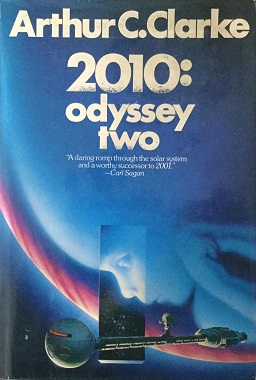
2010: Odyssey Two is a 1982 science fiction novel by British writer Arthur C. Clarke. It is the sequel to his 1968 novel 2001: A Space Odyssey, though Clarke changed some elements of the story to align with the film version of 2001.

The Dragon in the Sea (1956), also known as Under Pressure from its serialization, is a novel by Frank Herbert. It was first serialized in Astounding magazine from 1955 to 1956, then reworked and published as a standalone novel in 1956. A 1961 2nd printing of the Avon paperback, catalog # G-1092, was titled 21st Century Sub with the previous title in parentheses, and a short 36 page version of the novel was later collected in Eye. It is usually classified as a psychological novel.

Cosmos 1 was a project by Cosmos Studios and The Planetary Society to test a solar sail in space. As part of the project, an uncrewed solar-sail spacecraft named Cosmos 1 was launched into space at 19:46:09 UTC on 21 June 2005 from the submarine Borisoglebsk in the Barents Sea. However, a rocket failure prevented the spacecraft from reaching its intended orbit. Once in orbit, the spacecraft was supposed to deploy a large sail, upon which photons from the Sun would push, thereby increasing the spacecraft's velocity.
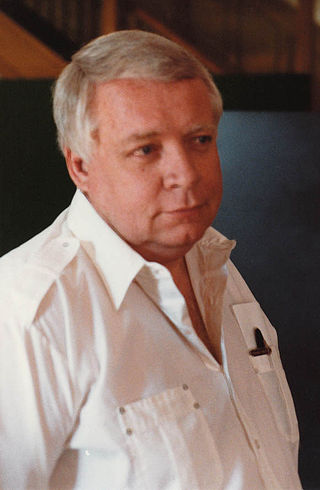
Algirdas Jonas "Algis" Budrys was a Lithuanian-American science fiction author, editor, and critic. He was also known under the pen names Frank Mason, Alger Rome, John A. Sentry, William Scarff, and Paul Janvier. He is known for the influential 1960 novel Rogue Moon.
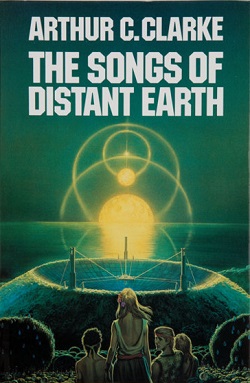
The Songs of Distant Earth is a 1986 science fiction novel by British writer Arthur C. Clarke, based upon his 1958 short story of the same title. He stated that it was his favourite of all his novels. Clarke also wrote a short step outline with the same title, published in Omni magazine and anthologized in The Sentinel in 1983.

The Wind from the Sun (ISBN 0-15-196810-1) is a 1972 collection of science fiction short stories by British writer Arthur C. Clarke. Some of the stories originally appeared in a number of different publications. A part of the book was included in CD on board the Planetary Society's solar sail, Cosmos 1.
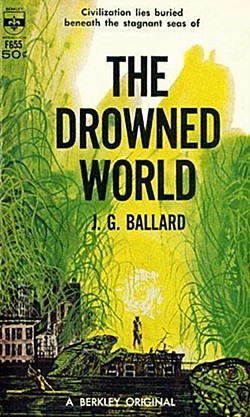
The Drowned World (1962), by J. G. Ballard, is a British science fiction novel that depicts a post-apocalyptic future in which global warming, caused by increased solar radiation, has rendered uninhabitable much of the surface of planet Earth. The story follows a team of scientists who are researching the environmental developments occurred in the flooded city of London. The novel is an expansion of the novella "The Drowned World", which was first published in Science Fiction Adventures magazine, in the January 1962 issue, Vol. 4, No. 24.
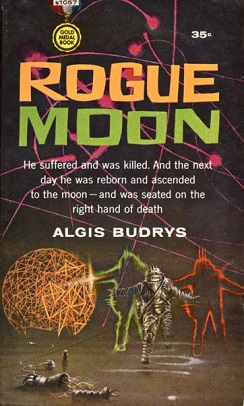
Rogue Moon is a short science fiction novel by American writer Algis Budrys, published in 1960. It was a 1961 Hugo Award nominee. A substantially cut version of the novel was originally published in F&SF; this novella-length story was included in The Science Fiction Hall of Fame, Volume Two, edited by Ben Bova. It was adapted into a radio drama by Yuri Rasovsky in 1979.

The Last Theorem is a 2008 science fiction novel by Arthur C. Clarke and Frederik Pohl. It was first published in the United Kingdom by HarperVoyager in July 2008, and in the United States by Del Rey Books in August 2008. The book is about a young Sri Lankan mathematician who finds a short proof of Fermat's Last Theorem, while an alien invasion of Earth is in progress.

An electric sail is a proposed form of spacecraft propulsion using the dynamic pressure of the solar wind as a source of thrust. It creates a "virtual" sail by using small wires to form an electric field that deflects solar wind protons and extracts their momentum. The idea was first conceptualised by Pekka Janhunen in 2006 at the Finnish Meteorological Institute.

LightSail is a project to demonstrate controlled solar sailing within low Earth orbit using a CubeSat. The project was developed by The Planetary Society, a global non-profit organization devoted to space exploration. It consists of two spacecraft — LightSail 1 and LightSail 2. LightSail 1 was an engineering demonstration mission designed to test its new sail deployment method in space, it did not perform solar sailing. LightSail 2 was a fully functional spacecraft intended to demonstrate true solar sailing and incorporated the lessons learned from LightSail 1. LightSail is a follow-on project to Cosmos 1 — a solar-sail spacecraft designed by The Planetary Society in the early 2000s, which was destroyed during a launch failure in 2005.

World's Best Science Fiction: 1966 is an anthology of science fiction short stories edited by Donald A. Wollheim and Terry Carr, the second volume in a series of seven. It was first published in paperback by Ace Books in 1966. It was reprinted by the same publisher in 1970 under the alternate title World's Best Science Fiction: Second Series. An Italian edition appeared in December 1966 under the title Il vento del sole.
Arthur C. Clarke (1917-2008) wrote a considerable number of short stories in the science fiction genre.

Sunjammer was a NASA mission intended to demonstrate a solar sail constructed by LGarde, but was canceled before launch. The largest solar sail made as of 2013, Sunjammer was named after a 1964 Arthur C. Clarke story of the same name, Sunjammer, in which several solar sails compete in a race to the Moon. Sunjammer was slated to launch in January 2015 as the secondary payload of a SpaceX Falcon 9 launch vehicle, along with the Earth observation satellite DSCOVR. Citing a lack of confidence in its contractor's ability to deliver, the mission was canceled in October 2014.

A Treasury of Science Fiction is an American anthology of science fiction short stories edited by Groff Conklin. It was first published in hardcover by Crown Publishers in 1948, and reprinted in March 1951. A later edition was issued by Bonanza Books/Crown Publishers in March 1980. An abridged paperback version including eight of its thirty stories was published by Berkley Books in July 1957 and reprinted in January 1958 and January 1965.
CubeSail is a proposed nanosatellite project by the Surrey Space Centre (SSC) in England. The spacecraft is to be a 3U CubeSat propelled by a 25 m²solar sail. The project is financed and technically supported by aerospace manufacturers Astrium and Surrey Satellite Technology.
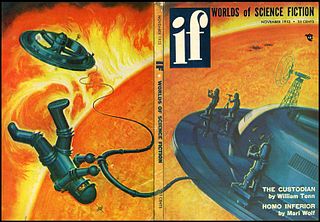
The Sun has appeared as a setting in fiction at least since classical antiquity, but for a long time it received relatively sporadic attention. Many of the early depictions viewed it as an essentially Earth-like and thus potentially habitable body—a once-common belief about celestial objects in general known as the plurality of worlds—and depicted various kinds of solar inhabitants. As more became known about the Sun through advances in astronomy, in particular its temperature, solar inhabitants fell out of favour save for the occasional more exotic alien lifeforms. Instead, many stories focused on the eventual death of the Sun and the havoc it would wreak upon life on Earth. Before it was understood that the Sun is powered by nuclear fusion, the prevailing assumption among writers was that combustion was the source of its heat and light, and it was expected to run out of fuel relatively soon. Even after the true source of the Sun's energy was discovered in the 1920s, the dimming or extinction of the Sun remained a recurring theme in disaster stories, with occasional attempts at averting disaster by reigniting the Sun. Another common way for the Sun to cause destruction is by exploding, and other mechanisms such as solar flares also appear on occasion.

















